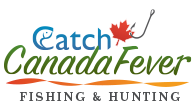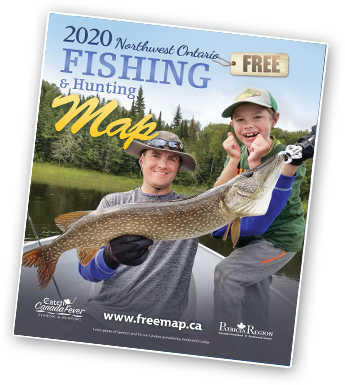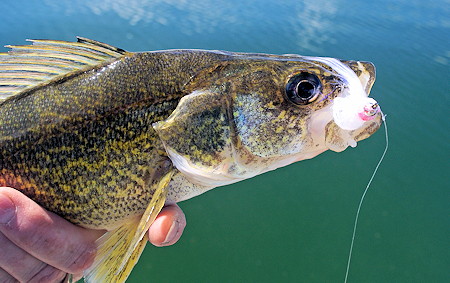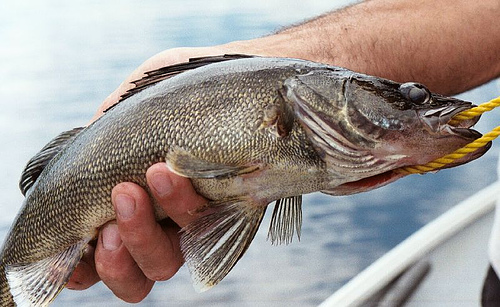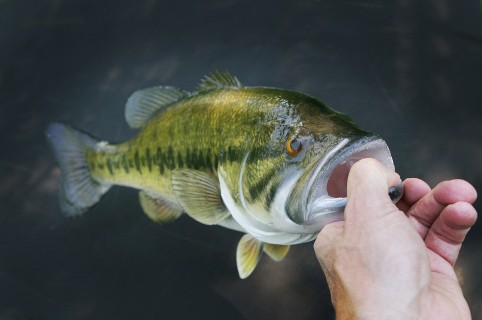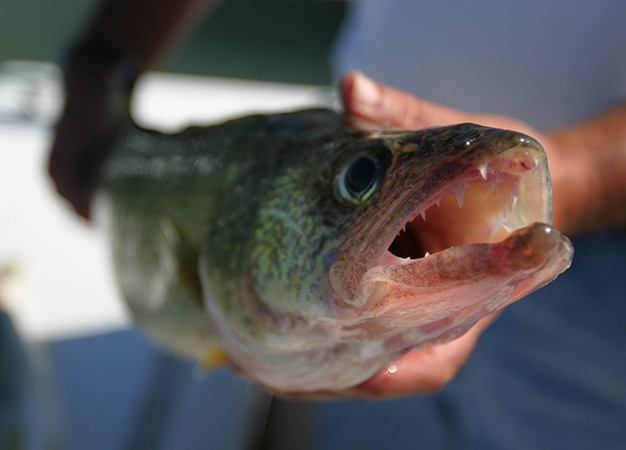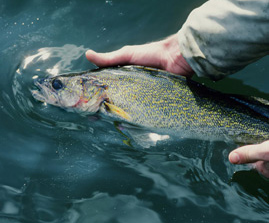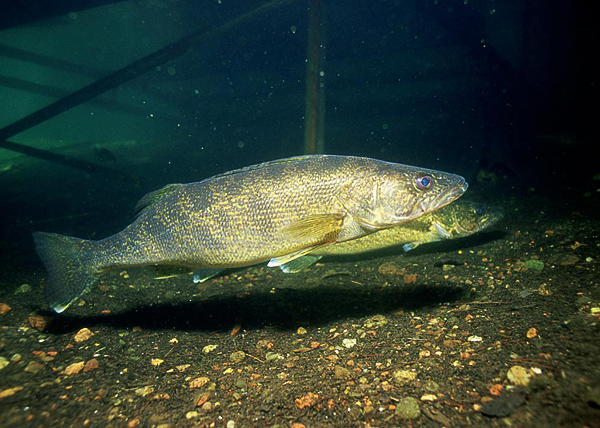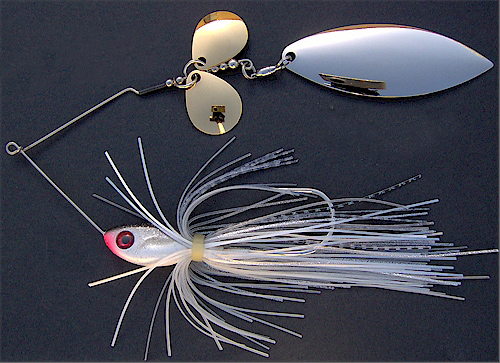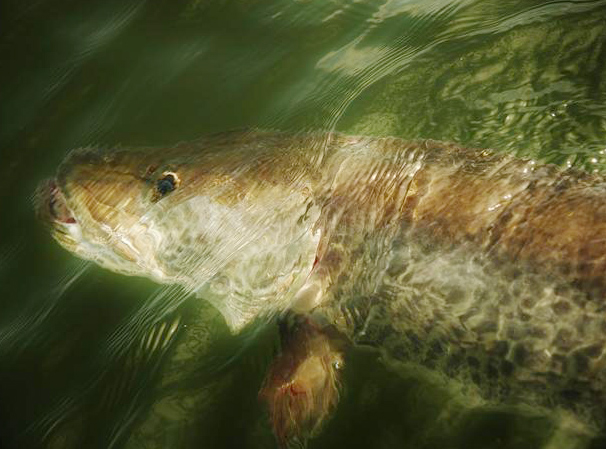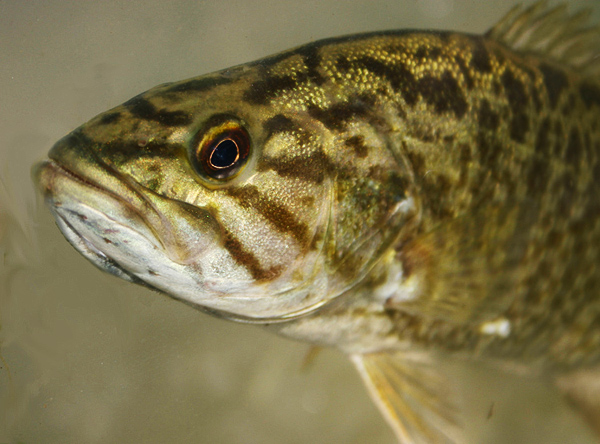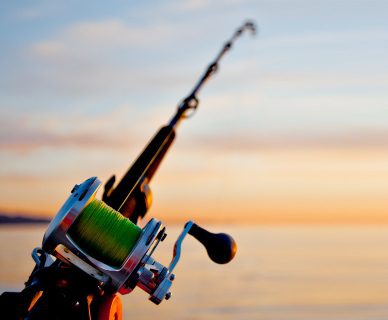The sheet of ice that lay ahead of us seemed endless, it might as well have been an arctic ice flow. For a second I stood there with no clue as to how to fish this seemingly limitless lake. Fortunately, my guide had a plan.
“We’re not going far,” he said, apparently sensing my concern. “There’s a weed-bed out about 300 yards, and the pike like to hunt in the grass.”
“How deep is it there?” I asked. Though I’ve ice fished hundreds of times, the size and possible depth of this bay near Hudson Bay was making me nervous. In the past I’d worked the same area from a boat and fished over what felt like bottomless depths. When my guide said we’d only be fishing over only 12 feet of water, it somehow made me feel a little bit better knowing we would be fishing shallow under the ice. I don’t know why.
 In some 40-minutes of hard work, we hiked to our weedbed location, drilled a field of 10-inch holes with a power auger, then set out tip-ups adorned with 4-inch shiners and some others with large suckers.
In some 40-minutes of hard work, we hiked to our weedbed location, drilled a field of 10-inch holes with a power auger, then set out tip-ups adorned with 4-inch shiners and some others with large suckers.
Before we had finished putting out all the equipment, one of the flags popped. “Go, go, go!” my guide yelled as I slid over the slick surface.
When I got to the tip-up, the submerged spool was spinning wildly, and the line was slanted hard under the ice. I’d seen this before, so I waited. When the spool and line stopped moving, I carefully lifted the tip-up, avoiding adding any extra pressure to the line.
By this time, the guide had caught up with me. “He’s stopped now,” I began,” when he runs again, I’ll sock it to him!”
The wait was painful. Instead of moving away, indicating the fish had turned the bait in its mouth and was going to swallow it, the braided line barely budged. I felt little ticks on the line, and the hard slant told me the fish was still there, but this was a very long delay.
“It’s a big bait,” my guide said, “Be patient.” I wish I had timed the interval between when the pike stopped and started moving again, but i can only estimate that it was at least 4 minutes. I’d waited before, but never as long as this.
When the fish finally started to swim off, it did so very slowly. I released a few inches of line, then waited again.
As if on cue, the big pike started to swim away at a steady pace. The guide prompted me to set the hook, and with a tug that would have yanked a tooth from a dinosaur’s mouth, I drove the point home. In response, the line zipped through my hands. A good 20 feet flew off the small spool, and I didn’t even try to hold back.
When the fish stopped, I began hauling it back. The pike came reluctantly, and frequently I had to stop when the strain got too much. After a good battle I got the fish under the hole where it proceeded to run two more sprints. Finally, the pike’s snout appeared in the center of the ice hole. With gloves off, my guide reached down and put his fingers close to the fishes flanks. I quickly lifted the line, and the pike’s long head appeared over the lip of the ice. The guide grabbed its tail and heaved. It all happened so quickly, I think we were as surprised as the fish.
When we weighed our fish on a digital scale, it barely missed 15 pounds. Taking good pike like that is a nice achievement, and on big-water lakes, there are even larger fish to be had. But these same lakes can be daunting.
Fortunately, ice anglers can dismiss a great deal of this, because pike are most often caught in shallow water. Indeed, most trophy pike are only caught in waters no more than 6 to 12 feet deep.
Another factor that helps ice angler locate fish on large lakes is the pike’s need for weeds. While pike may cruise in the open water, the chances of catching one there are few and far between.
The majority of pike hunt around the weedbeds, and that’s where the ice angler should fish for them.
While the weed-choked shores, bays, and flats of summer are long gone, a certain amount of stalk-type weeds, particularly milfoil and coontail, withstand winter. Often, these weeds are stubby and contain both black and green leaves, but they still provide a suitable hunting ground for pike. When you find a winter weedbed that appears more like July than January , concentrate your efforts in that location. Such growth is possible under winter conditions.
While fishing the bay, we spread 30 tip-ups across the flat that measured 100 yards long and 50 wide.
We were after numbers of smaller fish, as well as trophy pike, and the variety of our baits reflected that mindset. Many of our tip-ups were baited with 3- to 4- inch shiners, so we pretty much were assured a steady stream of smaller pike. But, a number of tip-ups were also baited with 10 inch suckers, and invariably, these baits produced the largest fish, including that first 15 pounder.
The strikes on big-bait lines were considerably fewer, though. It was such a good day that on a couple of occasions two of our flags popped up at the same time. To differentiate the tip-ups with the large suckers from the regular ones we wisely painted the main posts with fluorescent chartreuse and black stripes and marked the red flags with black dots. If one of these proclaimed a strike at the same time as a regular one, guess which we ran to first?
The shiners were attached to size 4 circle hooks, but the suckers were impaled on 2/0 and 3/0 sized hooks. We looped the point behind the dorsal fins of most of the bait. Such a connection allows a minnow to hold horizontally in the water. And I also brought a little trick to the table.
I hooked some of the shiners beneath the anal fin. I’m not exactly sure where I picked up this trick, but I’ve found that it motivates the bait to swim up rather than swim down. Where there is thick weed growth, it helps to keep the shiner off balance and deters it from burrowing into the weeds, thus making it more visible to the predator. I tried this trick on the suckers too, but I don’t think it had any affect on those hefty baits.
While circle hooks remove the need for hard hook-sets in open water, when fishing under the ice, you still need to wait for a pike to turn the bait in its mouth and then you still must give it a good yank to drive a hook into a pike’s hard jaw. However, circle hooks do increase mouth-hooking and reduce gut-hooking, and I find this a very positive aspect. Especially, when I intend to release most of what I catch. In fact, I no longer keep pike by size, but by where they are hooked. Fish that are easy to release unharmed are sent back under the ice. Those few that aren’t are kept.
When going for big pike in shallow water, heavy braided line is an absolute must. When a pike is hooked, it usually doesn’t run for open water. Instead, is digs farther down into the weeds, and braided line can cut a thin stalk almost as easy as a weed whacker. This helps you avoid toting an entire lawn as you fight the fish. Usually just the head of the pike is draped with weeds that somehow manage to slide down the line.
Wire leaders are also an absolute necessity. Allowing the pike to turn the bait in its mouth puts the line directly into the fish’s toothy mouth, almost guaranteeing a sliced line. For the big suckers, we used 12 to 15 inch black leaders rated at 25 pound test; fir the smaller shiners, 8-inch leaders rated at 12 and 15- pound test. I prefer single strand black wire as opposed to mono-filament-coated multi-strand silver wire.
There is one key trick of the trade for catching big pike under the ice, or any other large fish, for that matter including Walleye in winter.
Too many times, such fish are lost at angler, anglers the edge of the ice hole because they bump into the hard sheet and dislodge the hook. Sometimes they do this on their own, and that can’t be helped.
But when making that final landing action, you should attempt to get the pike’s snout centered in the ice hole and then quickly lift its head to avoid a collision with the ice on the way up.
If a friend can help you lift the body and tail, so much the better. While my guide removed gloves to do this, I’ve seen anglers with garden ribbed gloves perform this same service.
Big water can be a daunting place to ice-fish for pike. However, if you concentrate on the weedy shallows, you won’t feel like you’ve bitten off more than you can chew.
Leave that to the pike.

